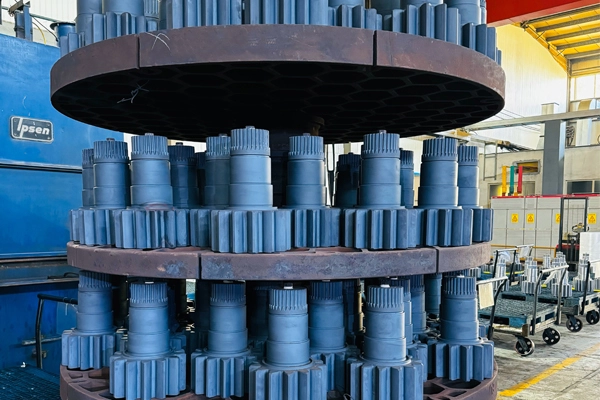Objective of Carbon Case Hardening for Castings and Forgings
The main objectives of carbon case hardening are:
Surface Hardness and Wear Resistance: To increase the hardness and wear resistance of the component's surface, making it ideal for parts exposed to abrasion, friction, and wear.
Fatigue Resistance: To enhance the component's ability to withstand cyclic loading, reducing the risk of failure from fatigue.
Core Toughness: To maintain the toughness and ductility of the core material, providing a tough, impact-resistant center while offering a hardened, wear-resistant exterior.
Improved Longevity: To extend the life of components by creating a hard surface layer that resists wear and minimizes the risk of surface degradation.
Selective Hardening: To selectively harden specific areas of a part, making it suitable for components with varying hardness requirements across different regions.
The Carbon Case Hardening Process for Castings and Forgings
The carbon case hardening process involves several key stages:
1. Preparation:
The casting or forging is cleaned to remove any oxides, grease, or contaminants that could interfere with the carburizing process. This can involve sandblasting, ultrasonic cleaning, or chemical cleaning, depending on the complexity and material of the part.
2. Carburizing:
The component is heated in a carburizing atmosphere—typically a carbon-rich gas, such as methane, propane, or carbon monoxide, or a solid carburizing medium, such as charcoal or graphite. This heating process is carried out at temperatures between 850°C to 1,000°C (1,562°F to 1,832°F).
The carburizing atmosphere allows carbon atoms to diffuse into the surface of the material. The carbon content of the outer layer is increased, creating a hardened “case” while the inner core retains its original carbon content and toughness.
3. Soaking:
Once the component has reached the desired carburizing temperature, it is held at that temperature for a specified period, known as the soaking time. The soaking period allows the carbon to diffuse into the surface to a depth that meets the hardness and wear resistance requirements.
The depth of the case can vary depending on the material and the intended application, typically ranging from 0.5 mm to 3 mm (0.02 in to 0.12 in) for most parts, though deeper cases can be achieved for specific applications.
4. Quenching:
After carburizing, the component is rapidly cooled (quenched) in a liquid medium such as oil, water, or brine. The rapid cooling causes the outer surface, which has a higher carbon content, to transform into a martensitic microstructure, increasing the surface hardness.
Quenching also helps to lock in the desired material properties by rapidly locking the carbon atoms into the structure, creating a strong, wear-resistant case.
5. Tempering (Optional):
After quenching, the part is often tempered to reduce brittleness in the hardened surface and achieve the desired balance of hardness and toughness.
The tempering process involves reheating the part to a lower temperature (typically between 150°C to 650°C or 302°F to 1,202°F), holding it for a specific period, and then allowing it to cool slowly. This helps to improve the overall toughness of the case while retaining the benefits of the surface hardness.
6. Post-Treatment Finishing:
Benefits of Carbon Case Hardening for Castings and Forgings
1. Improved Surface Hardness and Wear Resistance:
Carbon case hardening significantly enhances the hardness of the component’s surface, making it ideal for parts that experience high wear and abrasion. The hardened case resists surface degradation, providing long-lasting protection against friction, erosion, and other wear-related damage.
2. Enhanced Fatigue Strength:
By creating a tough core and a hard, wear-resistant surface, carbon case hardening improves the fatigue strength of the component. This makes the process especially beneficial for parts exposed to repeated loading and unloading, such as gears, camshafts, and crankshafts.
3. Maintaining Core Toughness:
One of the major advantages of carbon case hardening is that it allows the component to retain a tough, ductile core while providing a hard, wear-resistant exterior. This dual-property material is ideal for parts that need to withstand impact and shock loads while resisting surface wear and fatigue.
4. Selective Hardening:
Carbon case hardening allows for selective hardening of specific areas of a component, which is beneficial for parts that experience varying stresses across different regions. For example, gears can be case-hardened in the teeth areas, which experience the highest wear, while the core of the gear remains tough to withstand the bending forces.
5. Improved Component Longevity:
The hardened outer layer extends the service life of components by preventing wear and reducing the likelihood of surface-related failures. This is particularly important in high-performance applications, where the reliability of components is crucial for ensuring system uptime and preventing costly repairs.
6. Cost-Effective Process:
Applications of Carbon Case Hardening for Castings and Forgings
Carbon case hardening is widely used in industries where parts are subject to high wear, fatigue, and mechanical loading. Some of the most common applications include:
· Automotive Industry:
Gears, camshafts, crankshafts, axle shafts, and other drivetrain components that require high wear resistance and fatigue strength.
Valve seats, rocker arms, and components that need to resist wear and surface degradation while maintaining a tough core.
· Heavy Machinery:
Components such as gears, axles, shafts, and other parts used in construction, mining, and agricultural machinery, where high wear resistance is needed for long-term operation in harsh environments.
· Energy Sector:
Power generation equipment, such as turbine parts and pressure valves, that need high surface hardness for prolonged service under extreme thermal and mechanical stresses.
· Tooling & Dies:
Dies, molds, and tooling components used in metal forming, stamping, and injection molding, where surface hardness is crucial.
 English
English  Deutsch
Deutsch  français
français  русский
русский  فارسی
فارسی  العربية
العربية  Español
Español  日本語
日本語  한국어
한국어  italiano
italiano  português
português  dansk
dansk  Suomi
Suomi 










